REDDAM EARLY LEARNING SCHOOL LINDFIELD NEWSLETTER


This is also important for our younger students at Reddam ELS Lindfield. One of the most favourite parts of my day is visiting our stage 1 classrooms. You may have also had the wonderful experience of walking past our babies and have a happy wave or being blown a kiss from our beautiful babes. Recently we have increased our times outdoors and changed our routine so the children are outdoors earlier in the morning and later in the afternoon.
The babies and toddlers are no exception and in a recent visit to the classroom, it was lovely to see the bubs playing in their beautifully shaded playground with the mud kitchen, blocks to climb on and the tiny tent to hide in. Of course, just like our older students the babies and toddlers love to garden, they may have a different style of gardening and have to be reminded how to keep the plants in the dirt but nonetheless they are enjoying their time with the educators caring for our environment.
The benefits of outdoor play for babies are many, As stated by ACECQA Australian Children’s Education and Care Quality Authority: “Outdoor experiences are an important part of children’s healthy growth, learning, wellbeing and development. The benefits of outdoor learning environments and engagement in nature play for young children are varied and many. Encouraging babies to spend time in the outdoor environment (including touching sand, grass, dirt or leaves), has potential health benefits and can help stimulate their immune systems. “ ACECQA , 2019 Having the separate playgrounds for all the stages here at Reddam ELS Lindfield provide an opportunity for our youngest to explore their environment freely without the concern of older children interrupting the children’s experience or space.
Outdoor play for babies and toddlers extends all developmental areas and is a great backdrop for experiences provided by our educators to extend the children’s self awareness of where they fit into the world whilst increasing their feeling of belonging, being and becoming.
“Opportunities to move freely, grasp objects, kick legs, crawl and observe others running and playing supports physical development. Research indicates that spending time in fresh air also encourages better healthy sleep patterns for babies as they begin to understand the difference between night and day.
Making sense of new sights, smells, textures and sounds stimulates brain development and provides a foundation for learning by encouraging discovery and exploration. “ ACECQA 2019
Our educators here at Reddam are reflecting as a team on increasing the intentional learning opportunities that occur in our outdoor play areas for our 1 and 2 year olds. The use of the natural environment incorporating play spaces that include visual arts, drama and music where children can explore and engage with the world around them is what we as a team continually strive towards “When educators engage in outdoor learning experiences with and alongside children, there are further opportunities for social exchange, relationship building and language development.” ACECQA 2019

Reminders
Graduation and Christmas Concert
These dates have now been confirmed with all classrooms so please lock into your diaries. All family members are welcome to attend
Tuesday 6 th December 2022 9:30am 4E
Wednesday 7 th December 2022 3pm 3E
Thursday 8 th December 2022 9:30am 4R
Tuesday 13 th December 2022 3pm 2E
Tuesday 13 th December 2022 3pm 1R
Wednesday 14 th December 2022 3pm 1E
Thursday 15 th December 2022 3pm 2R
Friday 16 th December 2022 3pm 3R
2023 enrolments
Attendance changes for 2023 have now closed and we are working on confirming all applications received. If you would like to amend or inquire regarding your child's attendance, please feel free to get in touch with Chenise and your requests will be tended to following the confirmation of applications received prior to the close date, 28th October.
Looking forward to chatting with you soon.
Christine Irwin PrincipalIf camping is so great, why are the bugs always trying to get in your house? By Jim
 By Heather Gaskall
Gaffigan
By Heather Gaskall
Gaffigan
Welcome to Week 4 and what a super week we have had starting with some spooky fun for Halloween which coincided beautifully with our focus on minibeasts. The children jumped in with both feet to enjoy some Halloween fun at the beginning of the week with a witches brew potion. There were plenty of bats, rats and creepy ants in the potion with some spiders crawling about. Miss Doris set up an amazing sensory tray for the children with frozen spooky ice blocks made from baking soda. The children were then provided with eye droppers and vinegar to experiment the chemical reaction. This was a brilliant experience which involved experimentation of causes and effects plus fine motor skills. To top it all of the children were invited to enjoy a little face painting, just how cute did they look?
During the week, Miss Heather invited the children to view her collection of real minibeasts which included a christmas beetle, frog, moths, dragon fly, a cicada as well as a cicada shell. These were presented under glass and gave the children the opportunity to extend their knowledge of how real minibeasts looked.
During the week we also spent a day focusing on those special minibeasts, those wonderful little buzzy creatures, Bees! Bees are a very important link to our survival, without them we would not have food to eat. There is no other way to pollinate all our crops, trees and flowers as efficiently as with bees. The bee sensory table was not only a feast for their little fingers to manipulate the spoons but a feast of colour for the children to admire. Just like our friends the bees, our little ones were attracted by an array of colours. They helped the bees to flit from flower to flower gathering nectar to take back to the hive. They assisted the bees in doing their little dance that bees do to tell the others where the best nectar came from.
Another of our sensory tables for the week was an Ant City. The children were welcomed to a tray set up with sand, leaves, sticks and busy busy ants. The children inspected the habitat and helped the ants to march around looking for food. Ants are amazing little creatures to watch and the strength they have is over the top. We extended this ant experience when we went outside, we marched around like ants singing ‘The Ants go marching one by one’.
Miss Jaycel created an experience where the children played as palaeontologists. There were various minibeasts available such as beetles, grasshoppers, ladybugs, ants and more for the children to push into the playdough creating fossil like imprints. The children enjoyed seeing their creations and the effect of the bugs on the playdough. Another of the experiences invited the children to create their own minibeasts out of various natural items like leaves, sticks and seeds. The educators demonstrated how to create a bug to inspire the children to create their own creations. The children gathered around the table and used their best designing skills to create some amazing creations.
All these sensory experiences we provide the children are very important on many levels, they allow the children to use their senses, imaginations, fine motor skills and of course turn taking. That is above and beyond the fun of playing and learning. The social skills they develop while enjoying simple tasks like participating in group times are significant.
Wishing all our families a wonderful weekend!
Heather, Doris, Jenny, Jaycle and Yali
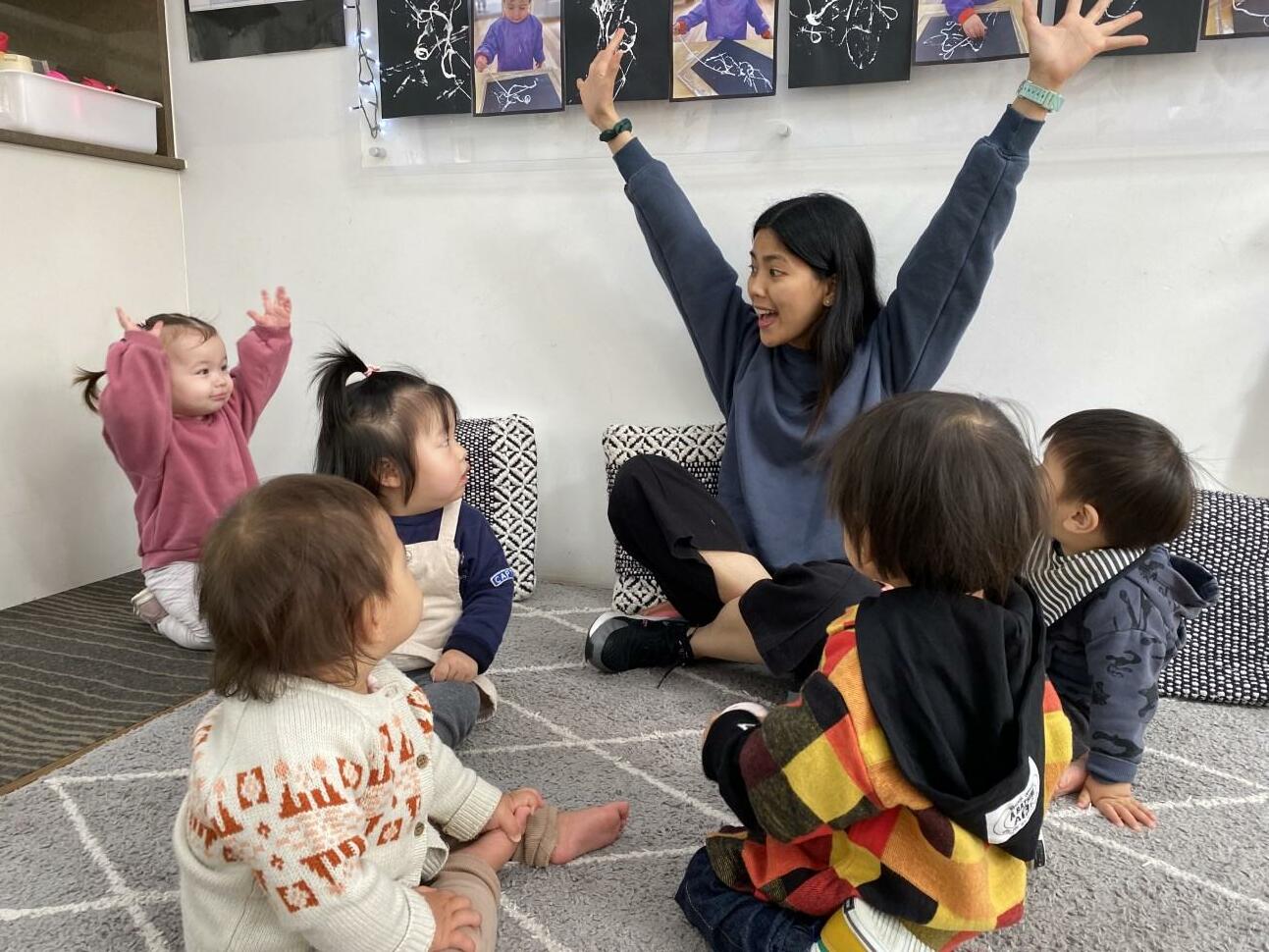

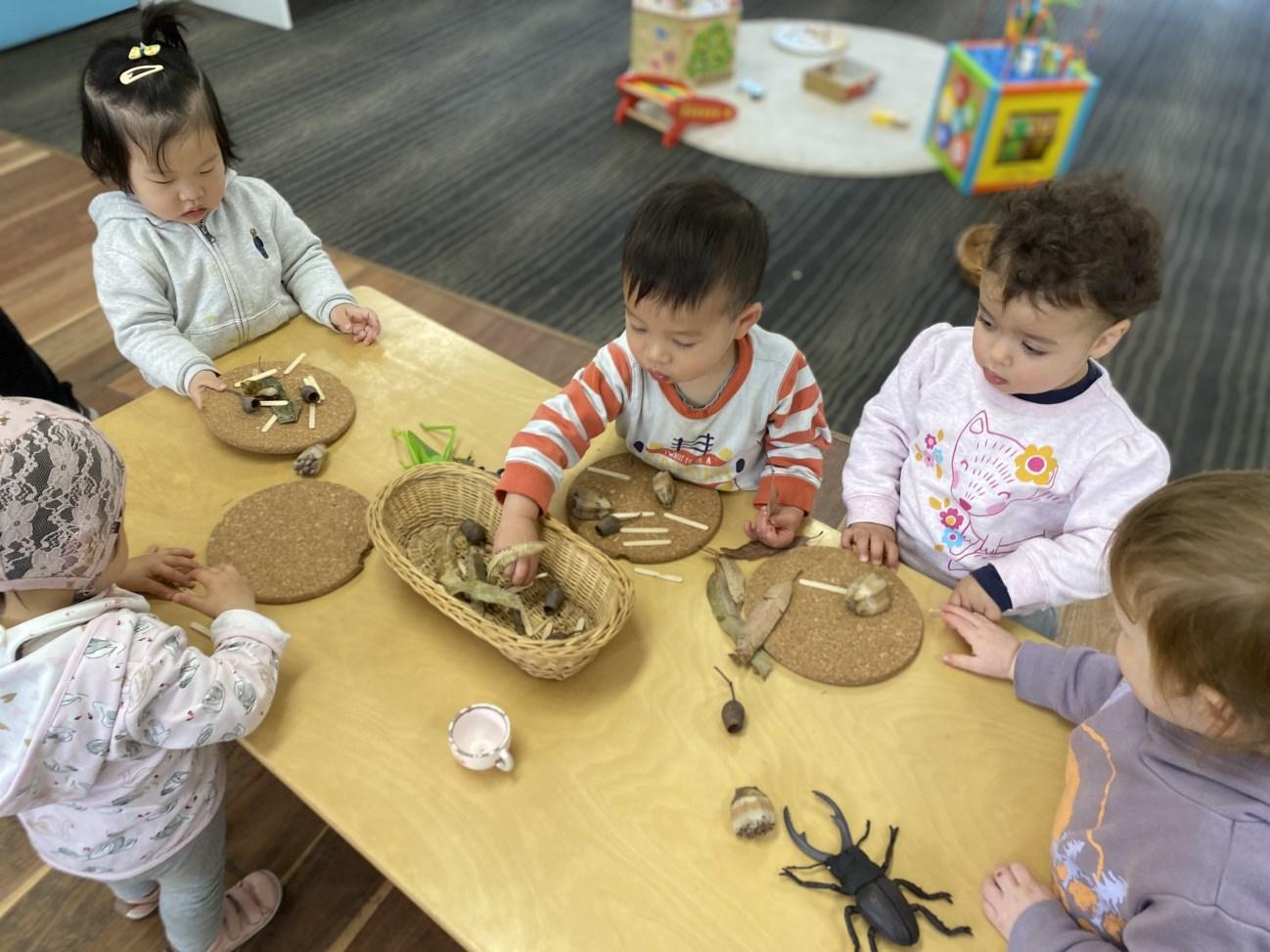

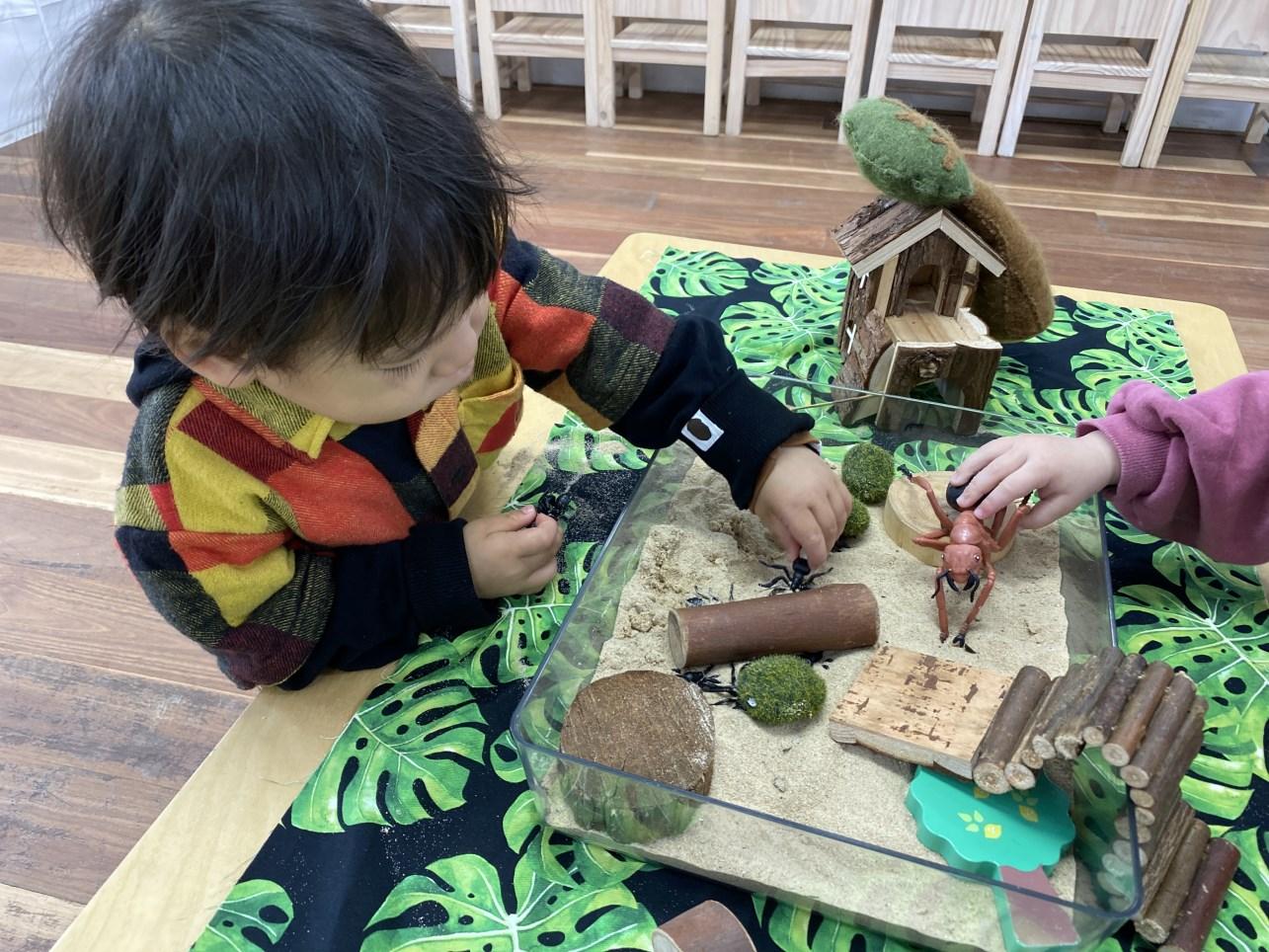

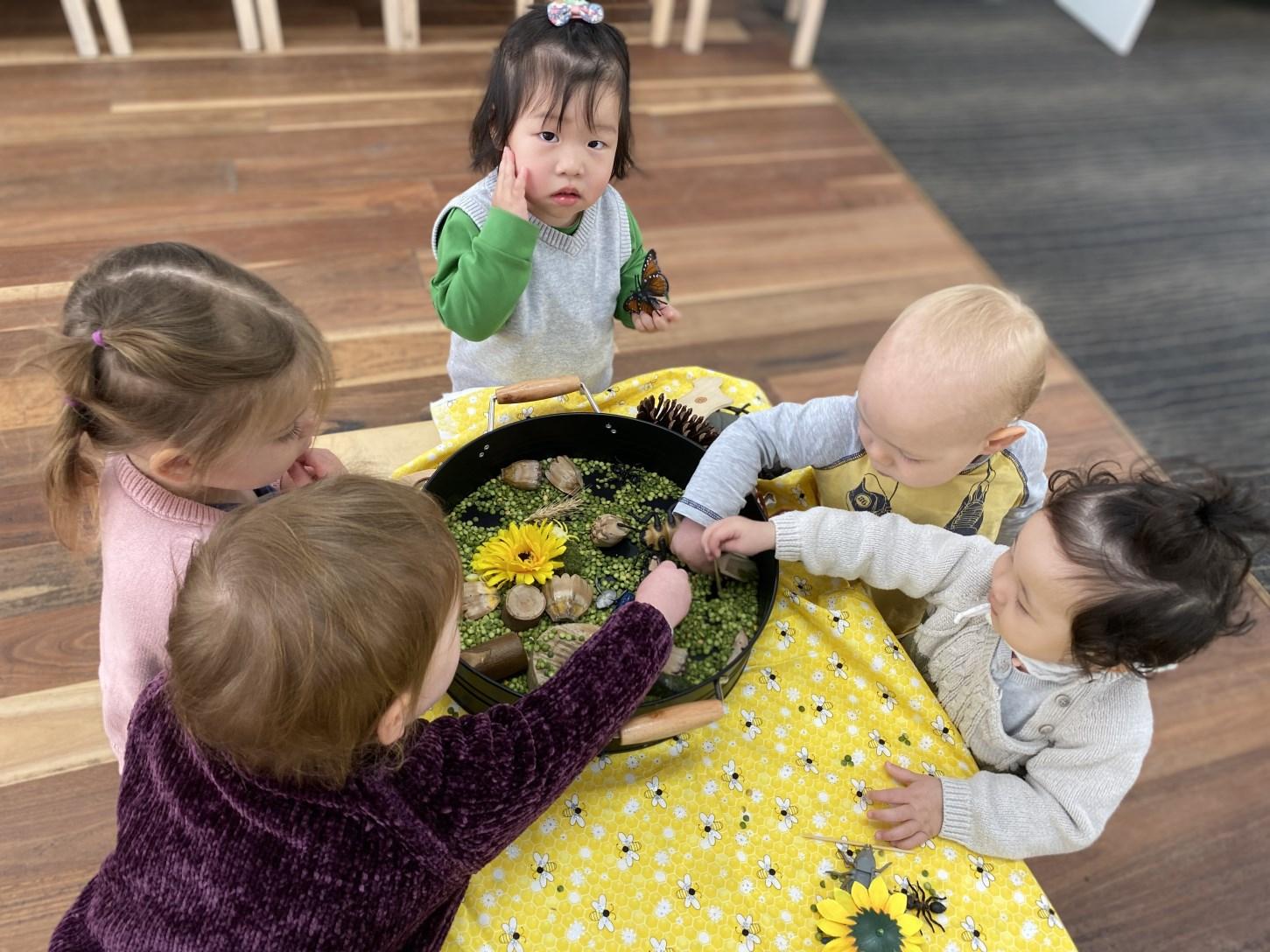


Continuing on our focus on building and developing the cognitive learning abilities of our 1E children, this week we increased this crucial developmental milestone through dramatic play, investigation, advanced puzzle pieces activities, and sorting types of Australian animals. Stretching their minds increases their problem solving skills, curiosity and creativity and imagination, all important for their growth and development.

An animal rescue activity was set up for the children to challenge and explore their problem solving and sensory skills. It invited children to use their senses and explore the sensation of the ‘cold’ item while also offering the opportunity to explore how to remove the items from the ice. Children also used mathematical skills when taking part in this activity. For example, they learned the differences between liquids and solids, at the same time building empathy towards the stuck animals touching base on their emotional skills.
As we support children's confidence and become emotionally and socially capable, we invite them for a cognitive and physical motor activity. This Sorting and Matching Activity involves matching the small coloured pom poms and placing them over the matching coloured paper board that have been placed on the provocation table. It is a great activity to develop fine motor control, coordination, concentration and learning about colours. Their young brains are wired for learning and pattern recognition, and the same openness that allows a toddler to learn a language also allows them to recognise patterns in the natural landscape.
Children have a natural desire to make sense of their world. It makes perfect sense when they are drawn to sorting activities such as what we provided for them this week: different types of natural items such as rocks, sticks, gum nuts, dried flowers and wooden blocks, as well as group of animals and colourful 3D shape blocks that were aimed to be explored and be categorised by our young learners according to their types and colours.
Teaching children how to think rather than what to think is a game changer in their growth and development. Educators, teachers and parents have to encourage children to think for themselves, follow their interests and explore the ideas that inspire their curiosities. They will be confident and independent learners, as well as become creative adults who can initiate and innovate.
Physical Motor Development: Fine and Gross Motor, is another topic that will be explored for the next two weeks. Week one will be all about the fine motor skills. Fine motor refers to the group of skills involved in the ability to manipulate smaller objects with the hands and fingers, for example, grasping, holding and pinching.
I hope everyone will have a wonderful weekend!
Charity, Resie, Rowel, May ,Mary and Yash
“Children must be taught how to think, not what to think.” (Margaret Mead)
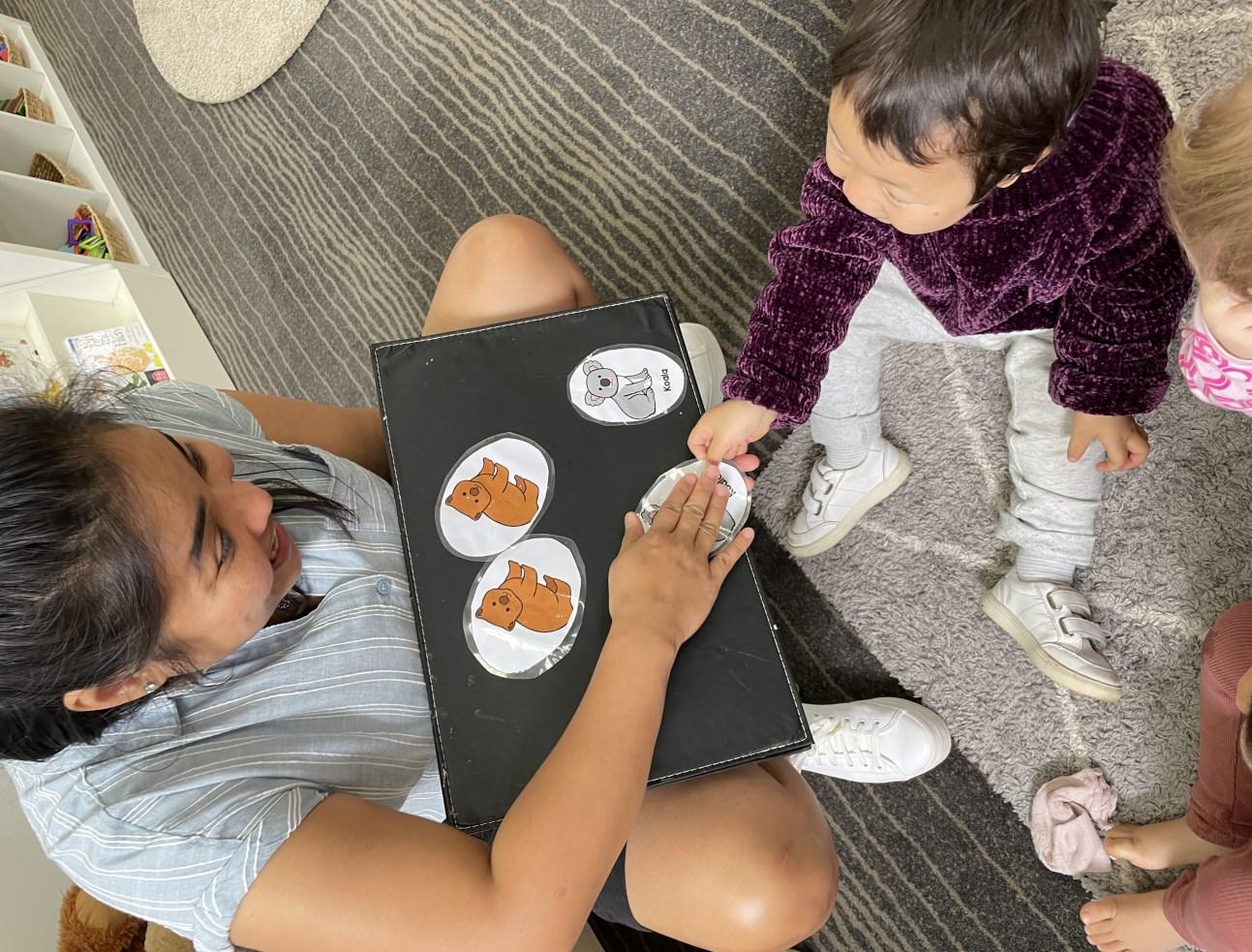





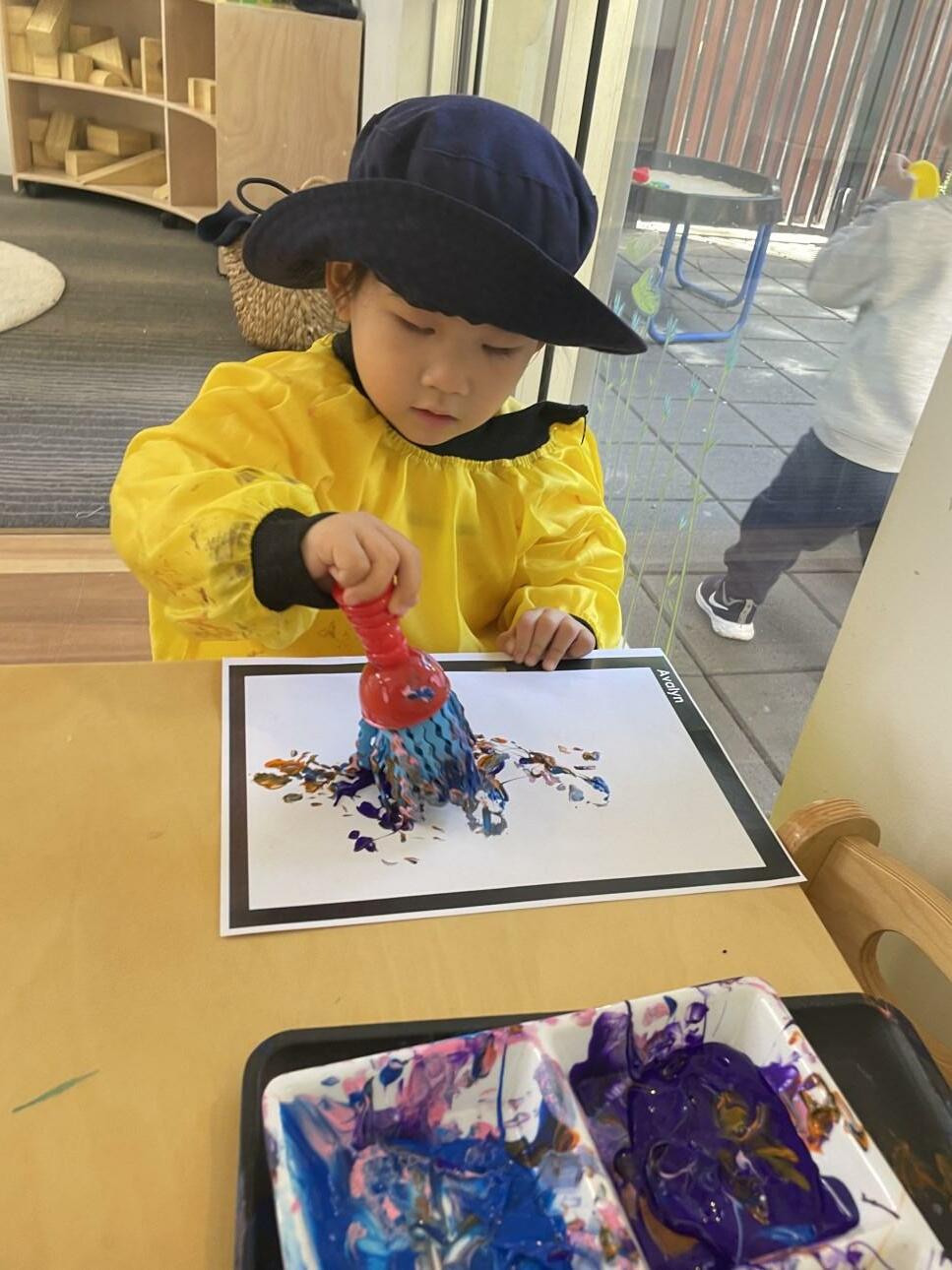

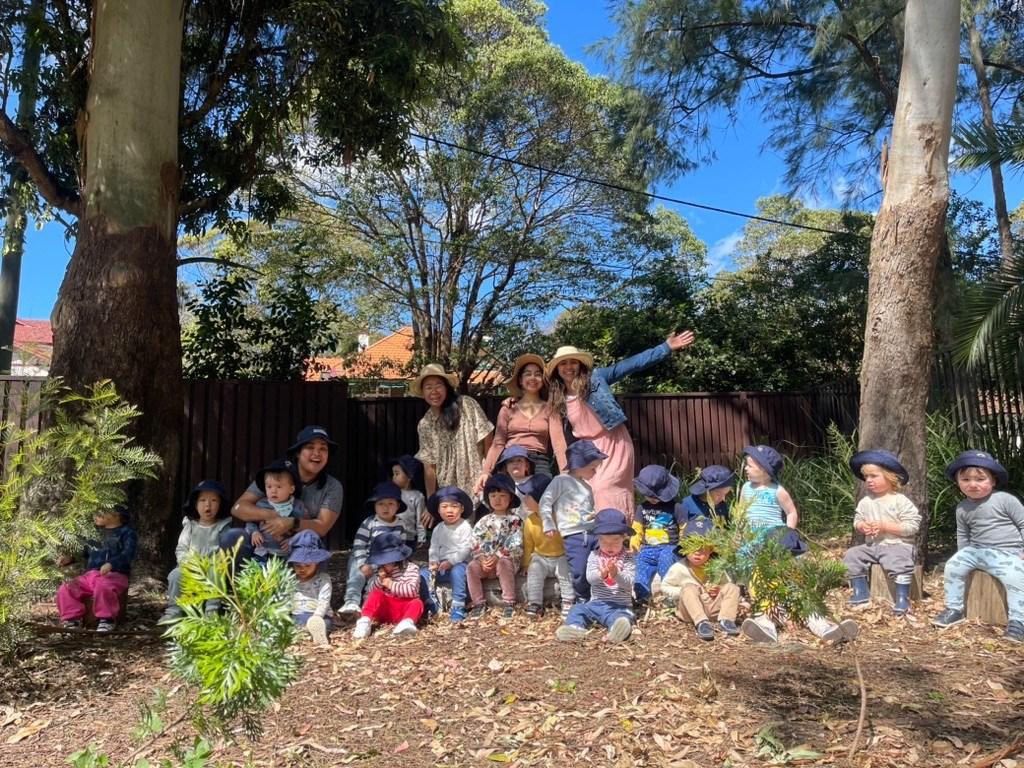
Regardless of the country we're raised in, we must instill a sense of acceptance and tolerance within our children. Children begin engaging with numerous people outside their immediate family and learning more about the larger world once they have mastered a language well enough to converse back and forth with others. We can introduce them from an early age to different world cultures, how they can expect to be treated by others, and how they should treat others. This week we celebrated American culture.
Throughout the week, our sensory experiences, including American themed playdough, rice sensory trays, shaving foam, and fizzing flags, introduced the children to the colours of American flags as well as developing their skills in all other areas. These experiences allow them to explore freely, encouraging their independence, introducing them to early mathematics skills, and engaging with problem solving skills.

As Neil Armstrong, an American astronaut, became the first human to step on the moon and did amazing experiments there, we decided to introduce his story in a play based way. With our moonwalking sensory trays, children pretended to be astronauts walking on the moon. Learning through sensory exploration comes naturally to young children as they simultaneously stimulate their senses. 2R had been seen utilising the 'scientific method' of observing, forming a hypothesis, experimenting, and making conclusions while they played!
Our cooking experience involved us making American burgers. The benefits of cooking with children are entirely worth the time and effort we spend with them. 2R was proud of their cooking and had an opportunity to learn about how burgers are made and where they come from.
To conclude our American week, we celebrated Halloween. With our Halloween sensory experiences, 2R actively experimented with emotional and social roles. This helped them develop feelings and build self esteem, language, thinking skills, and, more importantly, their imagination.
Every child interacts with the world differently, and how they think and act is also influenced by what they ask of and receive from others and their environment. Our goal in 2R has always been to support each child in understanding the distinctions they see so they may feel confident about who they are, where they belong in the world, and how different others are.
We wish happiness and peace for you this weekend!
“Everyone smiles in the same language.” (George Carlin)




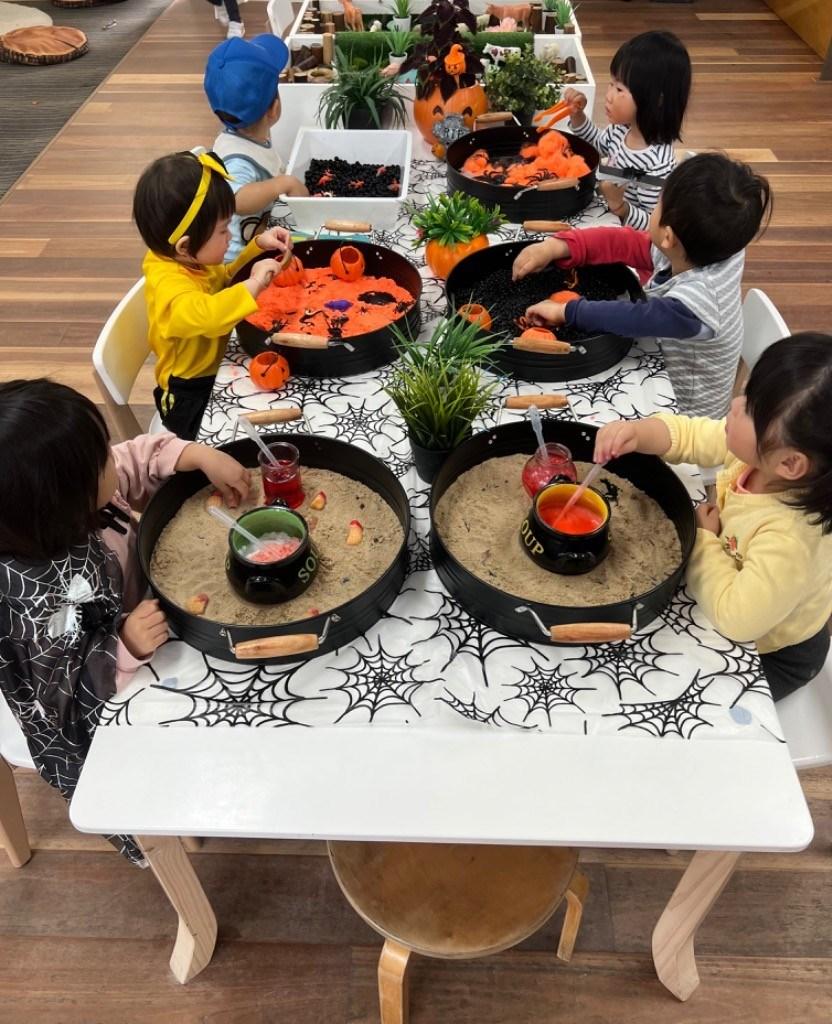





Naming feelings is the first step in helping young children learn to identify them. It allows children to develop an emotional vocabulary so they can talk about their feelings. Understanding feelings and emotions helps our 2E friends to build up confidence, showing them how to deal with challenges and strengthen self regulation and self esteem.
Happy children learn better! We incorporated all of the children's interests into our daily activities to promote their engagement and enjoyment in learning. Our classroom was filled with giggles, laughters and pleasant surprises as we focused on recalling HAPPY memories and understanding happy feelings through a range of bright yellow activities.
The highlight book of this week was When I’m Feeling Happy by Tracey Moreney. Following a bunny on a happy journey, we found out his happiness is similar to ours. He felt happy when he played with friends, helped his nana bake cookies, lent helping hands and went camping with his dad. Building upon the beautiful book, we went camping in a blue tent, enjoying marshmallows and mandarin ice blocks, cooking, making sandwiches for a picnic, using kind words, and playing nicely with friends. All these little things made us feel full of joy and happiness. Especially, 2E children feel happy when:
Aaron Z, Noah & Isla: "When I go to trick or treat"
Aaron Y: "Halloween"
Alyssa & Michelle: "Cuddle from mum and dad"
Thomas: "Cooking with mum and dad"

Ethan L: "When my mum and dad bring me to Dinosaurs Valley"
Laura: "When I'm with mummy"
Grace: "When I do trick or treat with mum, dad and Cooper"
Clara & Felicity: "When I'm with mum and dad"
Lucas W: "Go to see skeleton"
Lucas D: "Playing"
Aiden W: "When I go train museum"
At the art table, we explored a new concept of painting with a turntable which looked like a fairy wheel. We spinned and dropped different shades of yellow on our paper. This multiple dimension art attracted our children’s attention and they were fascinated about this art process. Have a happy weekend, Mia, Xanthe, Shandie, Chloe, Jing, Alisha and Ling
“World is brighter with the happiness of children.” (Mehmet Murat Ildan)
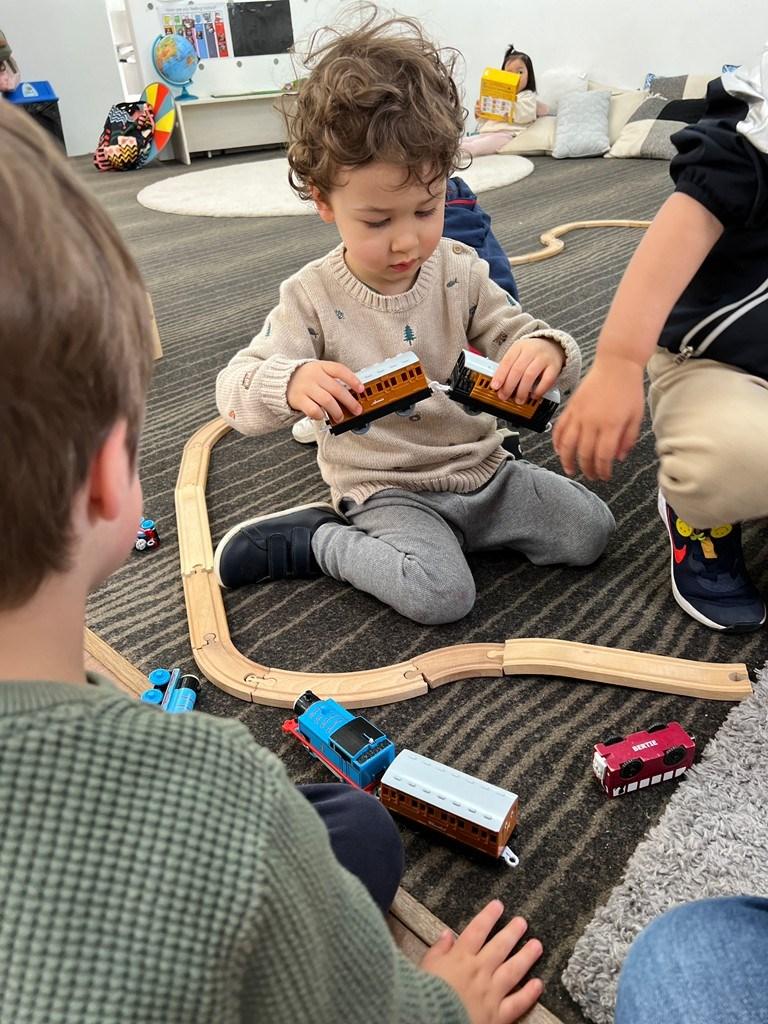








This week we continue to investigate dinosaurs as we revisit some of the initial questions asked by the children at the beginning of the term. Our table experiences saw friends exploring volcanoes, dinosaur letters and a collaborative painting experience using different sized dinosaur footprints to make prints. Children were also able to engage in independent experiences that invited them to trace the alphabet in volcano red kinetic sand. The children enjoyed this interesting texture by pressing letter shapes into the squishy sand. Next to this, the children referred to a tsunami infographic as they explored a tsunami bottle model. First, the children gathered the sand on one edge of the jar, then carefully created waves by tipping the bottle back and forth. At our sensory trays the children excavated dinosaur fossil cards from smooth black beans and vibrant yellow sand! The children also used this activity to match the cards with their figurine counterparts.

In Morning Meeting we revisited the causes of extinction with friends relaying their knowledge to the class
Myra "The big rock came from space"
Amelia "The volcanoes came and also the big wave moved the sand"
Angus "A tsunami... a big wave"
Another question asked in the morning meeting "Do you think the dinosaurs will come back?" The children sat, thought and shared with the class
Edmund “yes, cos they can’t get to the place they go to and they go the dinosaur museum”
Hana “Because the volcano is finished”
Avery “no, cos its lava and volcano”
Sarah “no cos of the lava”
Harry May “(Nods) the dinosaurs are strong and they’ll push the lava away”
Harry Murphy “dinosaurs eat meatballs”
Dylan “yes because they eat meat and they will come back”
Sebastian “no, cos there was a lot of dust”
Amelia LindsayWe remembered that the extinction was likely kickstarted by a comet hitting the Earth which cause earthquakes, volcano explosions and even tsunamis! With all the extreme natural disasters going on, the dinosaurs also had to worry about very cold weather and darkness caused by dust from the comet! Miss Carina also showed our little friends how to use our tsunami bottles carefully as they are made from glass. In our small groups today we saw friends staying inside with Mr Callum and Mr Sam to group and categorise the different dinosaurs into 'herbivore' and 'carnivore' classes and place them into either red or green hoops. The children used their knowledge of Dinosaur characteristics to sort and discuss. The group with Miss Carina looked at an even bigger tsunami model using sand, coloured water, dinosaurs as well as mountains and small rocks. The children discussed how tsunamis would have caused big problems for the dinosaurs like drowning, disrupting food sources as well as damaging their habitats. After the discussion then children took turns to make big waves in our model!
Mr Callum’s group visited the stage three veranda to create Dinosaur fossil prints with paint and our dinosaur play dough stamps! The children also tried to draw the dinosaurs with pencils.










During Week 4, the children have focused on extending upon their literacy and comprehension skills by listening to different picture books to expand their vocabulary, engaging in different small group activities and games and practising to write their name at the sign in table each morning. One of the books we read this week was called, “The Happiness Box” which was a story about hope during war times. The children seemed to enjoy identifying what the story could be about and drawing various illustrations of what they thought was happening as the story unfolded. We had some wonderful ideas including, “I think it’s about army” one child stated, another child pointed out, “The people have their bags” and another child proceeded to explain what they were going to draw, “The fire and war” This allowed the children to voice their own opinions and ideas, as well as use their creativity and imagination. The children were also provided with the opportunity to create their own creative story in small groups. They were invited to observe and look at a different picture book, which was called, “The Runaway Rabbit” and then work together in small groups to retell the story. This allowed the children to share their thoughts and feelings as the teacher put their ideas into sentences on the whiteboard, and then were able to design and create various illustrations to match each part of the story. The children continued to engage with their specialised lessons this week, where they could use their physical and gross motor skills as they practised throwing balls to each other, kicking and catching, as well as using another language to interact with each other. All these opportunities have allowed the children to build upon their literacy skills as they broaden their understanding of the world around them. Well done friends!

“Through literacy you can begin to see the universe. Through music you can reach anybody. Between the two there is you, unstoppable” (Grace Slick)








This week we extended on last week's interest in patterns by exploring 'Shapes'.
Our sensory trays were all themed around a different geometric shape. The 'circle' tray was filled with Orbeez, the 'square' tray had dice and cube shaped beads, the 'triangle' tray had magnetic triangles, and the 'hexagon' tray was full of a variety of different sized hexagons.
The children made geometric shapes by joining sticks with clay, and as they did so we discussed how many corners and sides each of the different shapes had. At the playdough station, the children were provided with a variety of geometric shape cookie cutters. They were seen naming the shapes, comparing them, and counting how many sides each shape had.
We learnt a new song about shapes that taught us all about the properties of squares, triangles, circles and rectangles. We then used this knowledge of how many sides and corners each shape has to make these shapes with our bodies. We read 'We are the Shapes' by Kevin Jenner and solidified our knowledge of the differences between triangles and squares. There was even an octagon in the story, and we discussed the difference between hexagons which have six sides and octagons which have eight sides. We also read 'Triangle' by Mac Barnett and Jon Klassen, discussed what shapes we saw in the story and noticed that triangles have three sides and three corners, whereas squares have four equal sides and four corners.
We searched for shapes in our environment throughout the week. In the dining area we noticed that the tables were rectangular, the cheese was cut into triangles and our plates were circles. Outside we noticed that the logs were circles, the A frames looked like triangles and the digging pit was a square!






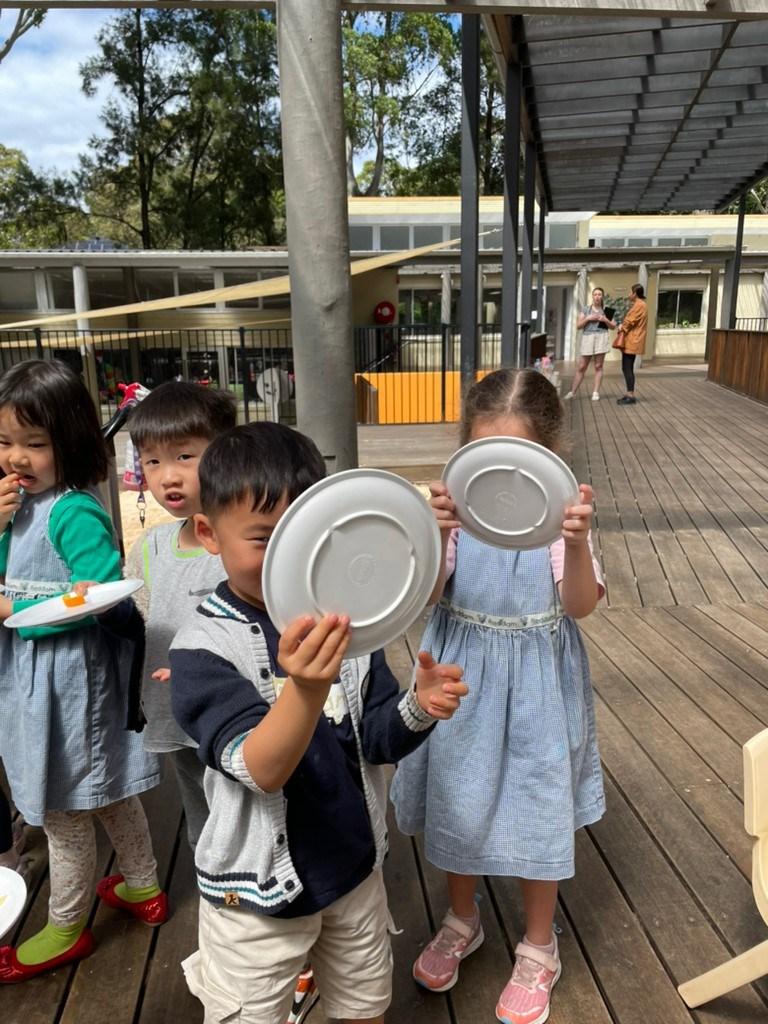



This week, we focused on what it means to feel angry, and how we can use strategies to calm ourselves down so that things don't escalate. Our story of the week was When I'm Feeling Angry by Trace Moroney. We read how Bunny felt angry when his friends made fun of him, wrecked his sandcastle or when he got blamed for doing something he didn't do. Our class discussed how we can take deep breaths, sit in a quiet spot for five minutes before we go back and join our friends, play with our favourite toys to cheer us up, do some yoga and rest our bodies.

During our morning sessions, the children engaged with a variety of red themed learning experiences to correspond with our red and angry Colour Monster. Red vinegar was provided to make volcanic eruptions, red play dough was rolled out and manipulated and red sand was used to pour and scoop. At our loose parts station, the children created more patterns with the stones, popsicle sticks, wooden shapes and bottle caps. Everyday, the children surprise the teachers with a different design. In our construction and small world area, we had lots of angry sharks, crabs, lobsters, and killer whales to role play with as the children created underwater stories. In our atelier, the children continued to create a picture inspired by Edvard Munch's 'The Scream'. Miss Lauren took the children's photos with their hands on their cheeks, with a frightened expression on their faces. We then looked at the original artwork and studied the lines made to create the background, and the screaming figure in the front of the picture. We wondered what the person was screaming about? Were they angry or frightened? The children then used watercolours and pastel crayons to create their backgrounds, focusing on making wavy lines, before cutting out and sticking their body on top.
Our fairy tale of the week was Goldilocks and the Three Bears. At our manipulation table the children explored volume and capacity with small, medium and large bowls to fill with rolled oats. Our class had a discussion about whether Goldilocks was in the wrong or not? Was it okay for her to enter someone else's house without permission? Daddy Bear was furious, while Mummy Bear was in shock. Baby Bear had tears in his eyes and was very sad. Some of the children then volunteered to assume the characters from the story and recited the dialogue from the fairy tale. They also noticed that the props were all large, medium and small to represent each bear. On Wednesday, the children also had their own porridge for afternoon tea, where they drizzled honey on top of it so it tasted…just right!
Next week we will revisit the black Colour Monster and discuss what makes us feel scared, frightened, worried and nervous. We will also take a walk with
“When little people are overwhelmed by big emotions, it’s our job to share our calm, not join their chaos.” (L.R. Knost)Thank you for a wonderful week of learning.










This week in drama we had a look at superheroes from stories and in real life. The thinking question for stage 3 and 4 was “what is a fruit or vegetable of the same colour as you are sitting on?” By far the hardest to name were blue and purple!

After our parachute play, Stage 1 had a look at all kinds of emotions and expressions. They watched as I sang “twinkle twinkle” in lots of different emotions including sad, angry, happy, and tired. Stage 1 then showed me their muscles and flew around the room like a superhero. They were visited by Timmy Turtle to finish their class.
In Stage 2, 3, and 4, we began by discussing all kinds of superheroes like firemen, police, paramedics, spider man, superman, and teachers. We played a quick game where I listed some superheroes and the children decided if they were good guys or bad guys. Afterwards, we discussed that there are lots of different emotions that we might need to use to convey a superhero character. We sang “twinkle twinkle” and used our faces and voices to express different emotions.
I told the children of a new superhero that is called Mr/Miss Muscles. They have that name because they are super strong from eating all their fruits and vegetables. The children mimed eating up all their food, showing me their muscles, and lifting something very heavy. This superhero has a special phone that receives emergencies from the community. When they received a call, they had to answer “Hello! What? Of course, we’ll be there soon!” Mr/Miss Muscles had a call from someone who saw a kitten stuck up a tree, an old lady who needed help crossing the road, a fire in a kitchen, and a robber stealing something valuable. We acted out each scenario together as a class.
In Stage 4, we split into two groups and acted out the police/robber scenario. Some children were the robbers and some were the police. The robbers mimed stealing something valuable, the police received the call, and then the two groups worked together to act out being caught and sending the robber to jail. We practised our slow motion skills. The children confidently said “You’re under arrest!”
After our superhero scenarios, Stage 3 and 4 broke off into pairs to do a mirror and statue exercise. The pairs faced each other one person moved while the other copied. We also had a go
